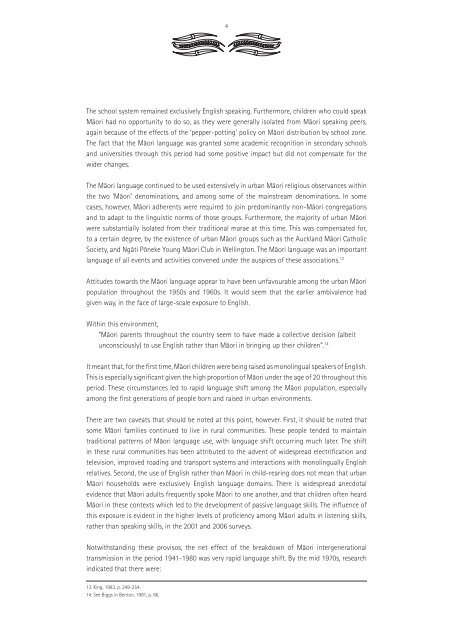The Health of the Maori Language in 2006 - Te Puni Kokiri
The Health of the Maori Language in 2006 - Te Puni Kokiri
The Health of the Maori Language in 2006 - Te Puni Kokiri
You also want an ePaper? Increase the reach of your titles
YUMPU automatically turns print PDFs into web optimized ePapers that Google loves.
4<br />
<strong>The</strong> school system rema<strong>in</strong>ed exclusively English speak<strong>in</strong>g. Fur<strong>the</strong>rmore, children who could speak<br />
Mäori had no opportunity to do so, as <strong>the</strong>y were generally isolated from Mäori speak<strong>in</strong>g peers,<br />
aga<strong>in</strong> because <strong>of</strong> <strong>the</strong> effects <strong>of</strong> <strong>the</strong> ‘pepper-pott<strong>in</strong>g’ policy on Mäori distribution by school zone.<br />
<strong>The</strong> fact that <strong>the</strong> Mäori language was granted some academic recognition <strong>in</strong> secondary schools<br />
and universities through this period had some positive impact but did not compensate for <strong>the</strong><br />
wider changes.<br />
<strong>The</strong> Mäori language cont<strong>in</strong>ued to be used extensively <strong>in</strong> urban Mäori religious observances with<strong>in</strong><br />
<strong>the</strong> two ‘Mäori’ denom<strong>in</strong>ations, and among some <strong>of</strong> <strong>the</strong> ma<strong>in</strong>stream denom<strong>in</strong>ations. In some<br />
cases, however, Mäori adherents were required to jo<strong>in</strong> predom<strong>in</strong>antly non-Mäori congregations<br />
and to adapt to <strong>the</strong> l<strong>in</strong>guistic norms <strong>of</strong> those groups. Fur<strong>the</strong>rmore, <strong>the</strong> majority <strong>of</strong> urban Mäori<br />
were substantially isolated from <strong>the</strong>ir traditional marae at this time. This was compensated for,<br />
to a certa<strong>in</strong> degree, by <strong>the</strong> existence <strong>of</strong> urban Mäori groups such as <strong>the</strong> Auckland Mäori Catholic<br />
Society, and Ngäti Pöneke Young Mäori Club <strong>in</strong> Well<strong>in</strong>gton. <strong>The</strong> Mäori language was an important<br />
language <strong>of</strong> all events and activities convened under <strong>the</strong> auspices <strong>of</strong> <strong>the</strong>se associations. 13<br />
Attitudes towards <strong>the</strong> Mäori language appear to have been unfavourable among <strong>the</strong> urban Mäori<br />
population throughout <strong>the</strong> 1950s and 1960s. It would seem that <strong>the</strong> earlier ambivalence had<br />
given way, <strong>in</strong> <strong>the</strong> face <strong>of</strong> large-scale exposure to English.<br />
With<strong>in</strong> this environment,<br />
“Mäori parents throughout <strong>the</strong> country seem to have made a collective decision (albeit<br />
unconsciously) to use English ra<strong>the</strong>r than Mäori <strong>in</strong> br<strong>in</strong>g<strong>in</strong>g up <strong>the</strong>ir children”. 14<br />
It meant that, for <strong>the</strong> first time, Mäori children were be<strong>in</strong>g raised as monol<strong>in</strong>gual speakers <strong>of</strong> English.<br />
This is especially significant given <strong>the</strong> high proportion <strong>of</strong> Mäori under <strong>the</strong> age <strong>of</strong> 20 throughout this<br />
period. <strong>The</strong>se circumstances led to rapid language shift among <strong>the</strong> Mäori population, especially<br />
among <strong>the</strong> first generations <strong>of</strong> people born and raised <strong>in</strong> urban environments.<br />
<strong>The</strong>re are two caveats that should be noted at this po<strong>in</strong>t, however. First, it should be noted that<br />
some Mäori families cont<strong>in</strong>ued to live <strong>in</strong> rural communities. <strong>The</strong>se people tended to ma<strong>in</strong>ta<strong>in</strong><br />
traditional patterns <strong>of</strong> Mäori language use, with language shift occurr<strong>in</strong>g much later. <strong>The</strong> shift<br />
<strong>in</strong> <strong>the</strong>se rural communities has been attributed to <strong>the</strong> advent <strong>of</strong> widespread electrification and<br />
television, improved road<strong>in</strong>g and transport systems and <strong>in</strong>teractions with monol<strong>in</strong>gually English<br />
relatives. Second, <strong>the</strong> use <strong>of</strong> English ra<strong>the</strong>r than Mäori <strong>in</strong> child-rear<strong>in</strong>g does not mean that urban<br />
Mäori households were exclusively English language doma<strong>in</strong>s. <strong>The</strong>re is widespread anecdotal<br />
evidence that Mäori adults frequently spoke Mäori to one ano<strong>the</strong>r, and that children <strong>of</strong>ten heard<br />
Mäori <strong>in</strong> <strong>the</strong>se contexts which led to <strong>the</strong> development <strong>of</strong> passive language skills. <strong>The</strong> <strong>in</strong>fluence <strong>of</strong><br />
this exposure is evident <strong>in</strong> <strong>the</strong> higher levels <strong>of</strong> pr<strong>of</strong>iciency among Mäori adults <strong>in</strong> listen<strong>in</strong>g skills,<br />
ra<strong>the</strong>r than speak<strong>in</strong>g skills, <strong>in</strong> <strong>the</strong> 2001 and <strong>2006</strong> surveys.<br />
Notwithstand<strong>in</strong>g <strong>the</strong>se provisos, <strong>the</strong> net effect <strong>of</strong> <strong>the</strong> breakdown <strong>of</strong> Mäori <strong>in</strong>tergenerational<br />
transmission <strong>in</strong> <strong>the</strong> period 1941-1980 was very rapid language shift. By <strong>the</strong> mid 1970s, research<br />
<strong>in</strong>dicated that <strong>the</strong>re were:<br />
13. K<strong>in</strong>g, 1983, p. 249-254.<br />
14. See Biggs <strong>in</strong> Benton, 1981, p. 66.

















